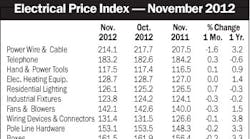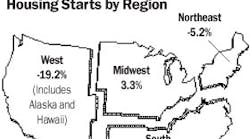Latest from Mag
People - Dec 21, 2012
Obituaries - Dec 21, 2012
November EPI Index Shows No Change
Housing Starts Dip 4% in November
Electrical Marketing - December 21, 2012
Around the Industry - Dec 21, 2012
AIA's Billing Index remains solid in January
On the heels of consecutive months of strengthening business conditions, the Architecture Billings Index (ABI) published monthly by the American Institute of Architects (AIA), Washington, D.C., has now reached positive territory three months in a row. As a leading indicator of construction activity, the ABI reflects the approximate nine- to twelve-month lag time between architecture billings and construction spending.
AIA reported the January ABI score was 50.9 points, following a mark of 51 points in December. This score reflects a slight increase in demand for design services (any score above 50 indicates an increase in billings). The new projects inquiry index was 61.2 points, down just a notch from a reading of 61.5 points the previous month.
“Even though we had a similar upturn in design billings in late 2010 and early 2011, this recent showing is encouraging because it's being reflected across most regions of the country and across the major construction sectors,” said AIA Chief Economist, Kermit Baker. “But because we still continue to hear about struggling firms and some continued uncertainly in the market, we expect that overall economic improvements in the design and construction sector to be modest in the coming months.”
Leading indicators continue pattern of slow improvement
The Conference Board Leading Economic Index (LEI) for the U.S. increased 0.4 percent in January to 94.9, following a 0.5 percent increase in December and a 0.3 percent increase in November. Said Ataman Ozyildirim, an economist at the Conference Board, “This fourth consecutive gain in the LEI reflected fairly widespread strength among its components, pointing to somewhat more positive economic conditions in early 2012. The LEI's increase in January was led not only by improving financial and credit indicators, but also rising average workweek in manufacturing. These both offset consumers' outlook about the economy, which remained pessimistic, though slightly less so.” Added Ken Goldstein, another Conference Board economist, “Recent data reflect an economy that started the year on a positive note. The LEI suggests these conditions will continue and could possibly even pick up this spring and summer.”
The Marketplace: Key Figures
(Billions of dollars, SAAR)2
(Thousands of units, SAAR)
(1977=100-SA)
Production workers (Thousands)4
(Millions of dollars, SA)2
(Millions of dollars, SA)2
(f.a.s. value in millions of dollars)2
(Bureau of Labor Statistics, 1967=100)
(Electrical Marketing, 1997=100)
(Bureau of Labor Statistics, 1982=100)
Sources: 1McGraw-Hill Construction/Dodge; 2Dept. of Commerce; 3Manufactured Housing Institute; 4Dept. of Labor; 5Federal Reserve Board; 6The Association for Manufacturing Technology; 7Federal Home Loan Bank Board.
Note: Some figures shown — prime rate, for example — are averaged for month. NYA — not yet available SA-seasonally adjusted. SAAR-seasonally adjusted annual rate. Source for chart: Global Insight.
For further information about construction starts, please contact Dodge Analytics at 1-800-591-4462

